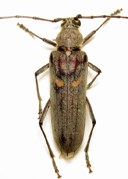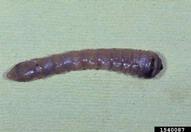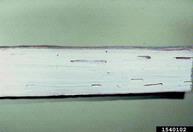Banded hickory borer
Knulliana cincta (Drury) (Coleoptera: Cerambycidae)
Orientation to pest
Banded hickory borer, Knulliana cincta (Drury), is native to North America and is found in the southern United States, west to Texas, and in northern Mexico. Three subspecies of this beetle have been named: Knulliana c. cincta (Drury), found in eastern North America west to Texas; Knulliana cincta ochracea (Bates), found in the southeastern United States, northeastern Mexico, and the Bahamas; and Knulliana cincta sonorensis (Schaeffer), found from Texas to Arizona, and adjacent regions in Mexico. This borer breeds in the dead branches and trunks of many hardwoods. The adult is dark brown and 1.6-3.0 cm long. The body is covered with gray hairs, and there are short sharp spines on the corners of the thorax. Each wing cover has a yellow spot across it, giving the appearance of a band across the back. Eggs are laid in summer beneath the bark or directly on the wood of recently felled, dying, or dead trees. The larvae feed under the bark during the remainder of the summer, forming galleries in the wood and ejecting frass through openings in the bark. During the fall and following summer larvae continue to feed in the wood and pupate in the fall or spring between lumps of frass at the end of the larval gallery. The life cycle most likely requires two years for completion. Cordwood, logs, posts, and rustic work may be damaged by this species. Adults are attracted to lights.
Hosts commonly attacked
This borer attacks hickory (Carya), pecan (Carya illinoinensis [Wangenh.] K. Koch), walnut (Juglans), oak (Quercus), eastern hophornbeam (Ostrya virginiana [Mill.] K. Koch), plum (Prunus), apple (Malus), chestnut (Castanea), hackberry (Celtis), pear (Pyrus), willow (Salix), mesquite (Prosopis),orange (Citrus), Sapindus, and Leucaena. Hickory appears to be preferred.
Distribution
This species is found in the United States from Virginia south to Florida and west to Oklahoma and Texas, and in northern Mexico.
Images of banded hickory borer
| Figure 1. Adult banded hickory borer, Knulliana cincta | Figure 2. Larva of banded hickory borer | Figure 3. Larval galleries of banded hickory borer |
Important biological control agents related to this pest species
Little is known of the natural enemies of this species, except that it is sometimes parasitized by the ichneumonid wasp Labena grallator (Say).






